ESP Lancia Voyager 2014 Owner handbook (in English)
[x] Cancel search | Manufacturer: LANCIA, Model Year: 2014, Model line: Voyager, Model: Lancia Voyager 2014Pages: 364, PDF Size: 3.49 MB
Page 244 of 364

GEAR RANGES
DO NOT race the engine when shift-
ing from PARK or NEUTRAL into
another gear range.
NOTE: After selecting any gear
range, wait a moment to allow the
selected gear to engage before ac-
celerating. This is especially im-
portant when the engine is cold.
PARK (P)
This range supplements the parking
brake by locking the transmission.
The engine can be started in this
range. Never attempt to use PARK
while the vehicle is in motion. Apply
the parking brake when leaving the
vehicle in this range.
When parking on a level surface, you
may shift the transmission into PARK
first, and then apply the parking
brake.
When parking on a hill, apply the
parking brake before shifting the
transmission to PARK, otherwise the
load on the transmission locking
mechanism may make it difficult to
move the shift lever out of PARK. Asan added precaution, turn the front
wheels toward the curb on a downhill
grade, and away from the curb on an
uphill grade.
WARNING!
Never use the PARK position as a
substitute for the parking brake.
Always apply the parking brake
fully when parked to guard
against vehicle movement and
possible injury or damage.
Your vehicle could move and in- jure you and others if it is not
completely in PARK. Check by
trying to move the shift lever out
of PARK with the brake pedal
released. Make sure the transmis-
sion is in PARK before leaving the
vehicle.
(Continued)
WARNING!(Continued)
It is dangerous to shift out ofPARK or NEUTRAL if the engine
speed is higher than idle speed. If
your foot is not firmly pressing
the brake pedal, the vehicle could
accelerate quickly forward or in
reverse. You could lose control of
the vehicle and hit someone or
something. Only shift into gear
when the engine is idling nor-
mally and your foot is firmly
pressing the brake pedal.
Unintended movement of a ve- hicle could injure those in or near
the vehicle. As with all vehicles,
you should never exit a vehicle
while the engine is running. Be-
fore exiting a vehicle, always ap-
ply the parking brake, shift the
transmission into PARK, turn the
engine OFF, and remove the key
fob. When the ignition is in the
LOCK position, the transmission
is locked in PARK, securing the
vehicle against unwanted move-
ment.
(Continued)
238
Page 245 of 364
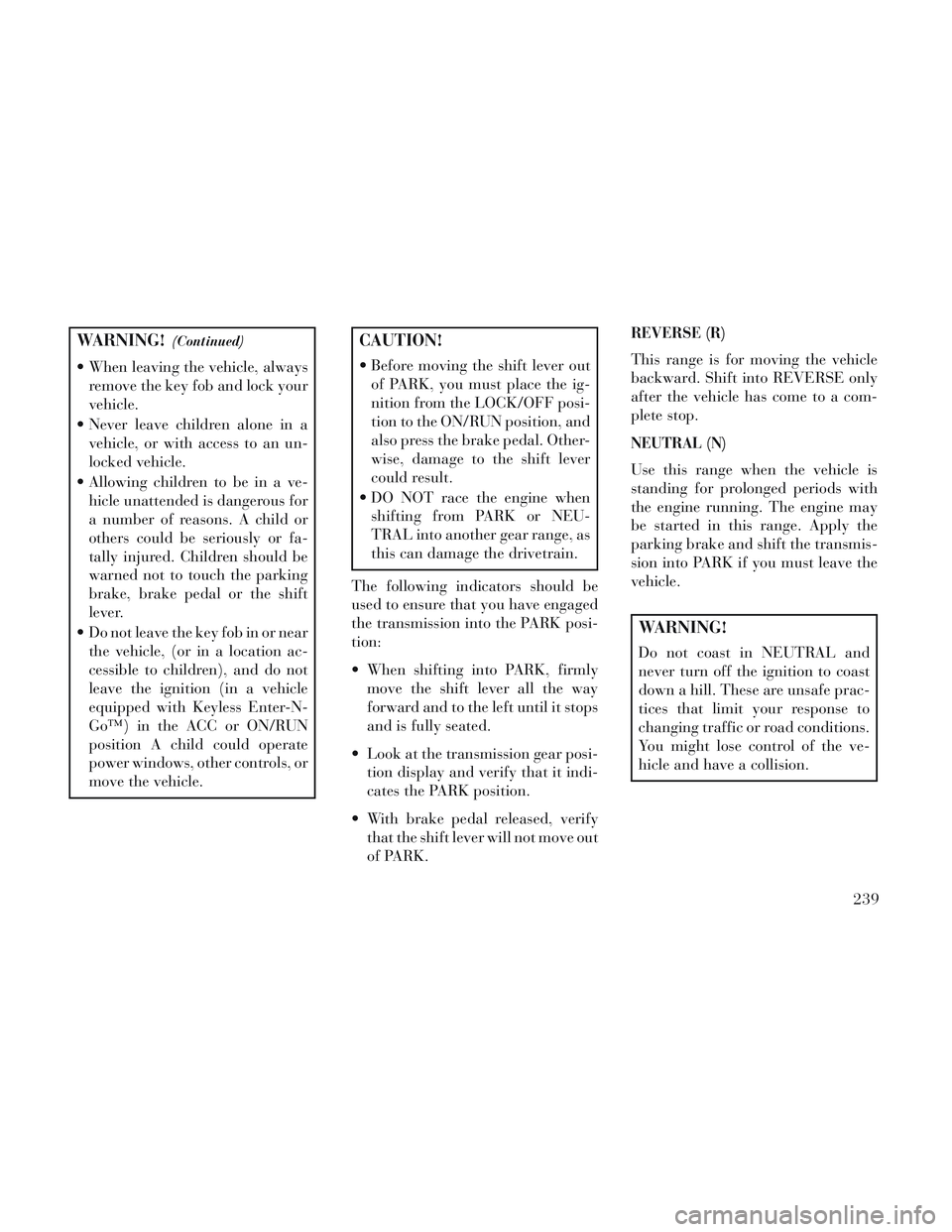
WARNING!(Continued)
When leaving the vehicle, alwaysremove the key fob and lock your
vehicle.
Never leave children alone in a vehicle, or with access to an un-
locked vehicle.
Allowing children to be in a ve- hicle unattended is dangerous for
a number of reasons. A child or
others could be seriously or fa-
tally injured. Children should be
warned not to touch the parking
brake, brake pedal or the shift
lever.
Do not leave the key fob in or near the vehicle, (or in a location ac-
cessible to children), and do not
leave the ignition (in a vehicle
equipped with Keyless Enter-N-
Go™) in the ACC or ON/RUN
position A child could operate
power windows, other controls, or
move the vehicle.
CAUTION!
Before moving the shift lever outof PARK, you must place the ig-
nition from the LOCK/OFF posi-
tion to the ON/RUN position, and
also press the brake pedal. Other-
wise, damage to the shift lever
could result.
DO NOT race the engine when shifting from PARK or NEU-
TRAL into another gear range, as
this can damage the drivetrain.
The following indicators should be
used to ensure that you have engaged
the transmission into the PARK posi-
tion:
When shifting into PARK, firmly move the shift lever all the way
forward and to the left until it stops
and is fully seated.
Look at the transmission gear posi- tion display and verify that it indi-
cates the PARK position.
With brake pedal released, verify that the shift lever will not move out
of PARK.
REVERSE (R)
This range is for moving the vehicle
backward. Shift into REVERSE only
after the vehicle has come to a com-
plete stop.
NEUTRAL (N)
Use this range when the vehicle is
standing for prolonged periods with
the engine running. The engine may
be started in this range. Apply the
parking brake and shift the transmis-
sion into PARK if you must leave the
vehicle.
WARNING!
Do not coast in NEUTRAL and
never turn off the ignition to coast
down a hill. These are unsafe prac-
tices that limit your response to
changing traffic or road conditions.
You might lose control of the ve-
hicle and have a collision.
239
Page 248 of 364
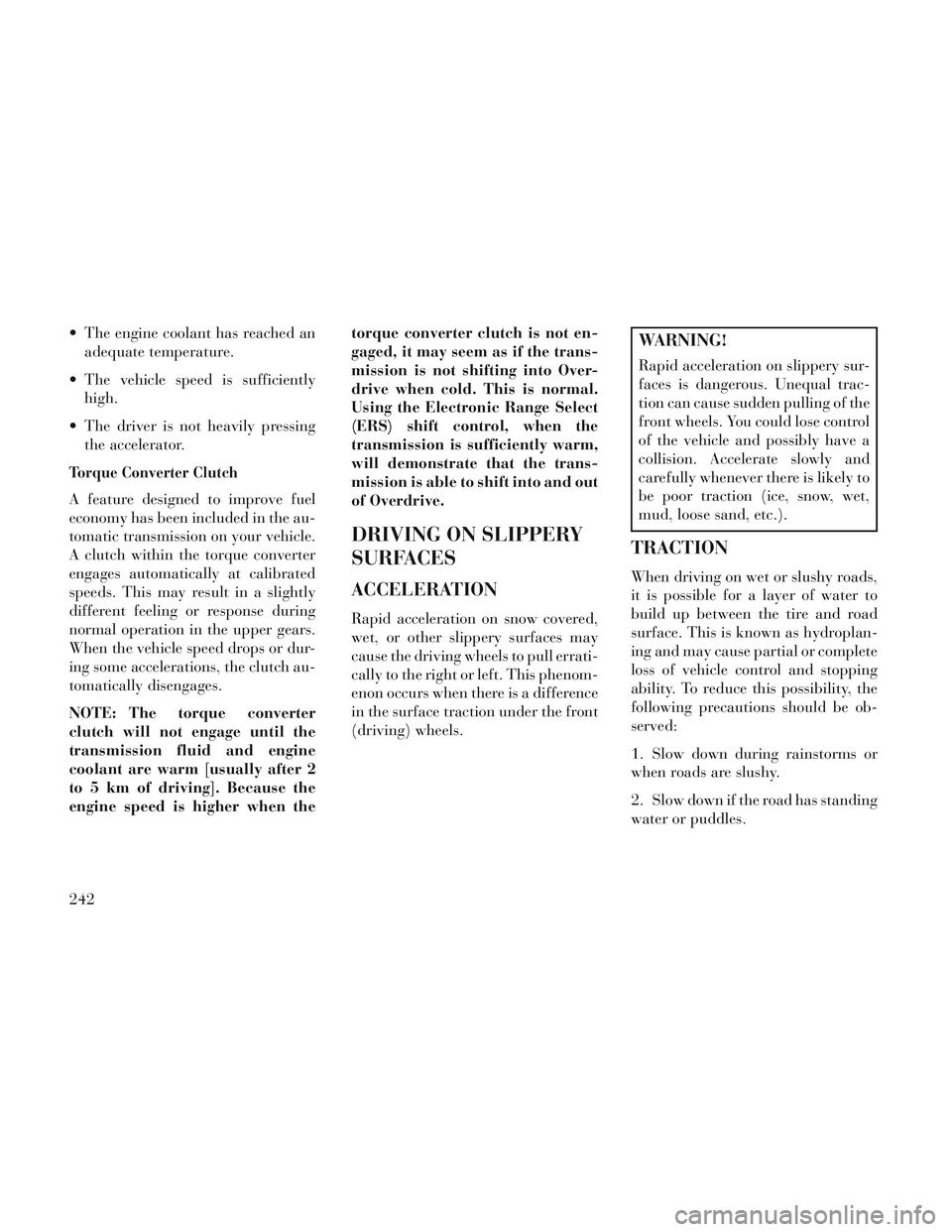
The engine coolant has reached anadequate temperature.
The vehicle speed is sufficiently high.
The driver is not heavily pressing the accelerator.
Torque Converter Clutch
A feature designed to improve fuel
economy has been included in the au-
tomatic transmission on your vehicle.
A clutch within the torque converter
engages automatically at calibrated
speeds. This may result in a slightly
different feeling or response during
normal operation in the upper gears.
When the vehicle speed drops or dur-
ing some accelerations, the clutch au-
tomatically disengages.
NOTE: The torque converter
clutch will not engage until the
transmission fluid and engine
coolant are warm [usually after 2
to 5 km of driving]. Because the
engine speed is higher when the torque converter clutch is not en-
gaged, it may seem as if the trans-
mission is not shifting into Over-
drive when cold. This is normal.
Using the Electronic Range Select
(ERS) shift control, when the
transmission is sufficiently warm,
will demonstrate that the trans-
mission is able to shift into and out
of Overdrive.
DRIVING ON SLIPPERY
SURFACES
ACCELERATION
Rapid acceleration on snow covered,
wet, or other slippery surfaces may
cause the driving wheels to pull errati-
cally to the right or left. This phenom-
enon occurs when there is a difference
in the surface traction under the front
(driving) wheels.
WARNING!
Rapid acceleration on slippery sur-
faces is dangerous. Unequal trac-
tion can cause sudden pulling of the
front wheels. You could lose control
of the vehicle and possibly have a
collision. Accelerate slowly and
carefully whenever there is likely to
be poor traction (ice, snow, wet,
mud, loose sand, etc.).
TRACTION
When driving on wet or slushy roads,
it is possible for a layer of water to
build up between the tire and road
surface. This is known as hydroplan-
ing and may cause partial or complete
loss of vehicle control and stopping
ability. To reduce this possibility, the
following precautions should be ob-
served:
1. Slow down during rainstorms or
when roads are slushy.
2. Slow down if the road has standing
water or puddles.
242
Page 250 of 364
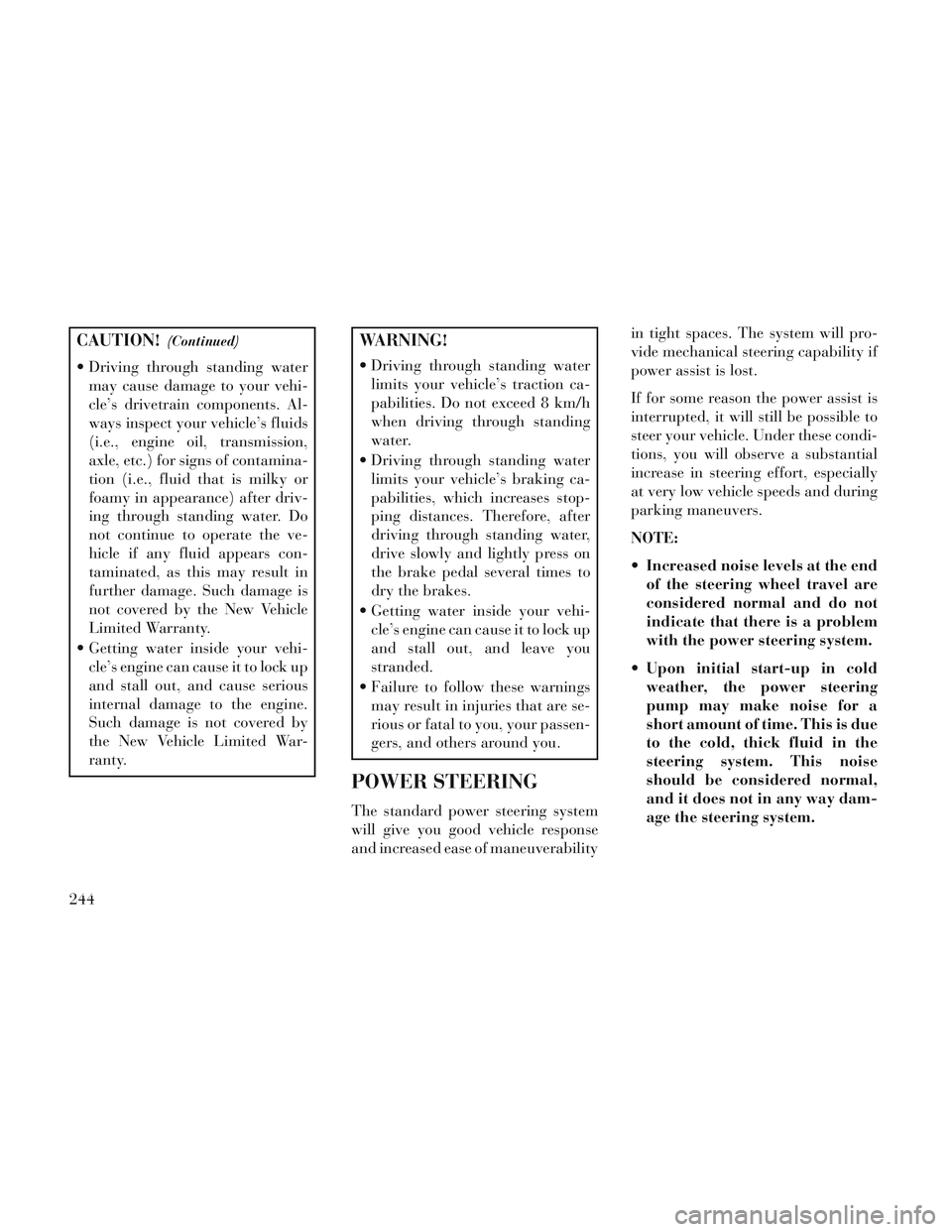
CAUTION!(Continued)
Driving through standing watermay cause damage to your vehi-
cle’s drivetrain components. Al-
ways inspect your vehicle’s fluids
(i.e., engine oil, transmission,
axle, etc.) for signs of contamina-
tion (i.e., fluid that is milky or
foamy in appearance) after driv-
ing through standing water. Do
not continue to operate the ve-
hicle if any fluid appears con-
taminated, as this may result in
further damage. Such damage is
not covered by the New Vehicle
Limited Warranty.
Getting water inside your vehi- cle’s engine can cause it to lock up
and stall out, and cause serious
internal damage to the engine.
Such damage is not covered by
the New Vehicle Limited War-
ranty.
WARNING!
Driving through standing waterlimits your vehicle’s traction ca-
pabilities. Do not exceed 8 km/h
when driving through standing
water.
Driving through standing water limits your vehicle’s braking ca-
pabilities, which increases stop-
ping distances. Therefore, after
driving through standing water,
drive slowly and lightly press on
the brake pedal several times to
dry the brakes.
Getting water inside your vehi- cle’s engine can cause it to lock up
and stall out, and leave you
stranded.
Failure to follow these warnings may result in injuries that are se-
rious or fatal to you, your passen-
gers, and others around you.
POWER STEERING
The standard power steering system
will give you good vehicle response
and increased ease of maneuverability in tight spaces. The system will pro-
vide mechanical steering capability if
power assist is lost.
If for some reason the power assist is
interrupted, it will still be possible to
steer your vehicle. Under these condi-
tions, you will observe a substantial
increase in steering effort, especially
at very low vehicle speeds and during
parking maneuvers.
NOTE:
Increased noise levels at the end
of the steering wheel travel are
considered normal and do not
indicate that there is a problem
with the power steering system.
Upon initial start-up in cold weather, the power steering
pump may make noise for a
short amount of time. This is due
to the cold, thick fluid in the
steering system. This noise
should be considered normal,
and it does not in any way dam-
age the steering system.
244
Page 260 of 364

EXAMPLE:
Service Description: 95= Load Index
— A numerical code associated with the maximum load a tire can carry
H = Speed Symbol
— A symbol indicating the range of speeds at which a tire can carry a load corresponding to its
load index under certain operating conditions
— The maximum speed corresponding to the speed symbol should only be achieved under speci-
fied operating conditions (i.e., tire pressure, vehicle loading, road conditions, and posted speed
limits)
Load Identification: "....blank...." = Absence of any text on the sidewall of the tire indicates a Standard Load (SL) tire
Extra Load (XL) = Extra load (or reinforced) tire
Light Load (LL) = Light load tire
C, D, E, F, G = Load range associated with the maximum load a tire can carry at a specified pressure
Maximum Load— Maximum load indicates the maximum load this tire is designed to carry
Maximum Pressure— Maximum pressure indicates the maximum permissible cold tire inflation pressure for this tire
254
Page 265 of 364

WARNING!(Continued)
Over-inflation reduces a tire'sability to cushion shock. Objects
on the road and chuckholes can
cause damage that result in tire
failure.
Over-inflated or under-inflated tires can affect vehicle handling
and can fail suddenly, resulting in
loss of vehicle control.
Unequal tire pressures can cause steering problems. You could lose
control of your vehicle.
Unequal tire pressures from one side of the vehicle to the other can
cause the vehicle to drift to the
right or left.
Always drive with each tire in- flated to the recommended cold
tire inflation pressure.
Economy
Improper inflation pressures can
cause uneven wear patterns to de-
velop across the tire tread. These ab-
normal wear patterns will reduce
tread life resulting in a need for earlier
tire replacement. Under-inflation also increases tire rolling resistance result-
ing in higher fuel consumption.
Ride Comfort And Vehicle
Stability
Proper tire inflation contributes to a
comfortable ride. Over-inflation pro-
duces a jarring and uncomfortable
ride. Both under-inflation and over-
inflation affect the stability of the ve-
hicle and can produce a feeling of
sluggish response or over responsive-
ness in the steering.
NOTE:
Unequal tire pressures from side
to side may cause erratic and
unpredictable steering re-
sponse.
Unequal tire pressure from side to side may cause the vehicle to
drift left or right.
Tire Inflation Pressures
The proper cold tire inflation pressure
is listed on the driver's side “B” Pillar
or rear edge of the driver's side door. At least once a month:
Check and adjust tire pressure with
a good quality pocket-type pressure
gauge. Do not make a visual judge-
ment when determining proper in-
flation. Tires may look properly in-
flated even when they are under-
inflated.
Inspect tires for signs of tire wear or visible damage.
CAUTION!
After inspecting or adjusting the
tire pressure, always reinstall the
valve stem cap. This will prevent
moisture and dirt from entering the
valve stem, which could damage
the valve stem.
Inflation pressures specified on the
placard are always “cold tire inflation
pressure”. Cold tire inflation pressure
is defined as the tire pressure after the
vehicle has not been driven for at least
three hours, or driven less than
1.6 km after a three hour period. The
cold tire inflation pressure must not
259
Page 266 of 364

exceed the maximum inflation pres-
sure molded into the tire sidewall.
Check tire pressures more often if
subject to a wide range of outdoor
temperatures, as tire pressures vary
with temperature changes.
Tire pressures change by approxi-
mately 7 kPa per 7°C of air tempera-
ture change. Keep this in mind when
checking tire pressure inside a garage,
especially in the winter.
Example: If garage temperature =
20°C and the outside temperature =
0°C then the cold tire inflation pres-
sure should be increased by 21 kPa,
which equals 7 kPa for every 7°C for
this outside temperature condition.
Tire pressure may increase from 13 to
40 kPa during operation. DO NOT
reduce this normal pressure build up
or your tire pressure will be too low.Tire Pressures For High
Speed Operation
The manufacturer advocates driving
at safe speeds and within posted speed
limits. Where speed limits or condi-
tions are such that the vehicle can be
driven at high speeds, maintaining
correct tire inflation pressure is very
important. Increased tire pressure
and reduced vehicle loading may be
required for high-speed vehicle op-
eration. Refer to your authorized tire
dealer or original equipment vehicle
dealer for recommended safe operat-
ing speeds, loading and cold tire infla-
tion pressures.
WARNING!
High speed driving with your ve-
hicle under maximum load is dan-
gerous. The added strain on your
tires could cause them to fail. You
could have a serious collision. Do
not drive a vehicle loaded to the
maximum capacity at continuous
speeds above 120 km/h.
Radial Ply Tires
WARNING!
Combining radial ply tires with
other types of tires on your vehicle
will cause your vehicle to handle
poorly. The instability could cause
a collision. Always use radial ply
tires in sets of four. Never combine
them with other types of tires.
Tire Repair
If your tire becomes damaged, it may
be repaired if it meets the following
criteria:
The tire has not been driven on when flat.
The damage is only on the tread section of your tire (sidewall dam-
age is not repairable).
The puncture is no greater than 6 mm.
Consult an authorized tire dealer for
tire repairs and additional informa-
tion.
260
Page 272 of 364
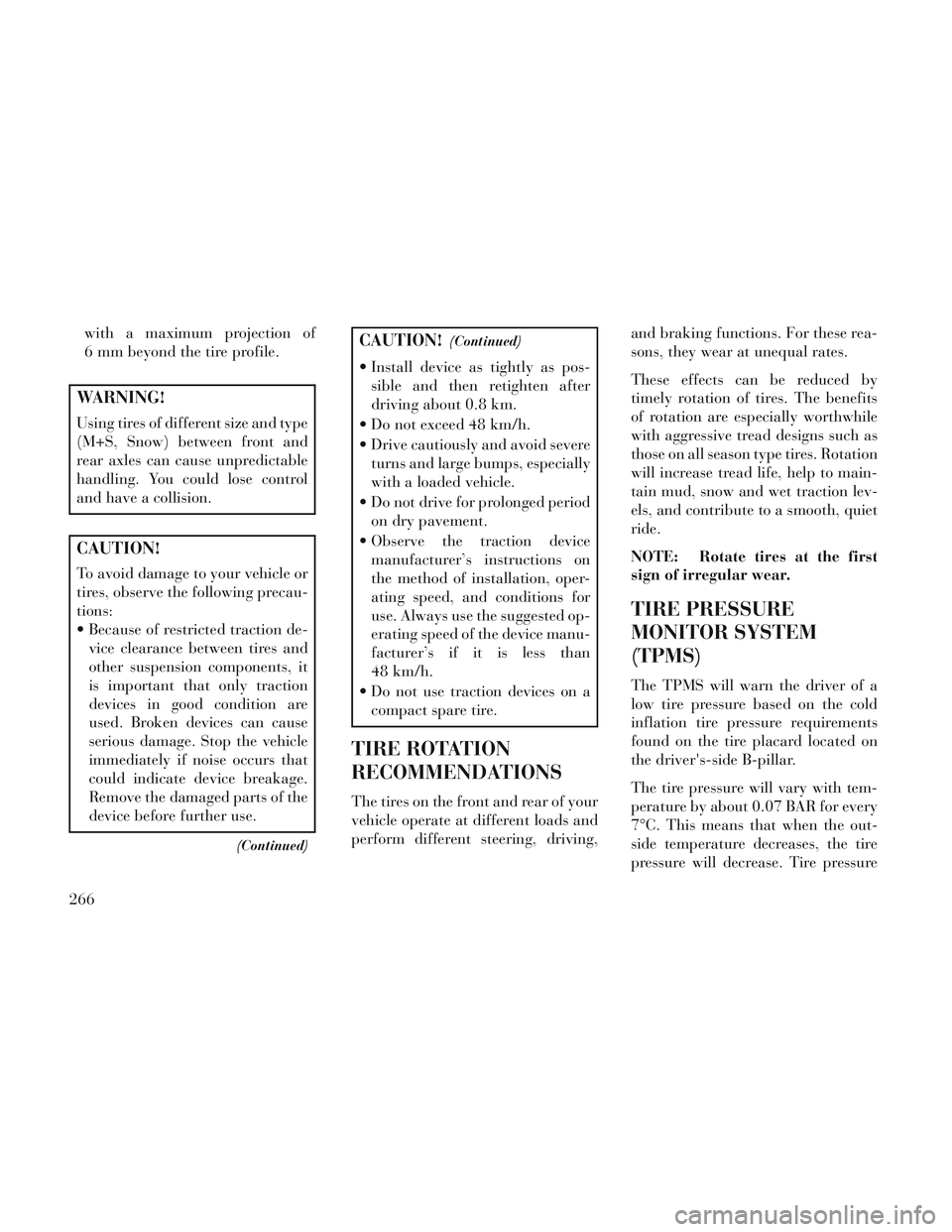
with a maximum projection of
6 mm beyond the tire profile.
WARNING!
Using tires of different size and type
(M+S, Snow) between front and
rear axles can cause unpredictable
handling. You could lose control
and have a collision.
CAUTION!
To avoid damage to your vehicle or
tires, observe the following precau-
tions:
Because of restricted traction de-vice clearance between tires and
other suspension components, it
is important that only traction
devices in good condition are
used. Broken devices can cause
serious damage. Stop the vehicle
immediately if noise occurs that
could indicate device breakage.
Remove the damaged parts of the
device before further use.
(Continued)
CAUTION!(Continued)
Install device as tightly as pos-sible and then retighten after
driving about 0.8 km.
Do not exceed 48 km/h.
Drive cautiously and avoid severe turns and large bumps, especially
with a loaded vehicle.
Do not drive for prolonged period on dry pavement.
Observe the traction device manufacturer’s instructions on
the method of installation, oper-
ating speed, and conditions for
use. Always use the suggested op-
erating speed of the device manu-
facturer’s if it is less than
48 km/h.
Do not use traction devices on a compact spare tire.
TIRE ROTATION
RECOMMENDATIONS
The tires on the front and rear of your
vehicle operate at different loads and
perform different steering, driving, and braking functions. For these rea-
sons, they wear at unequal rates.
These effects can be reduced by
timely rotation of tires. The benefits
of rotation are especially worthwhile
with aggressive tread designs such as
those on all season type tires. Rotation
will increase tread life, help to main-
tain mud, snow and wet traction lev-
els, and contribute to a smooth, quiet
ride.
NOTE: Rotate tires at the first
sign of irregular wear.
TIRE PRESSURE
MONITOR SYSTEM
(TPMS)
The TPMS will warn the driver of a
low tire pressure based on the cold
inflation tire pressure requirements
found on the tire placard located on
the driver's-side B-pillar.
The tire pressure will vary with tem-
perature by about 0.07 BAR for every
7°C. This means that when the out-
side temperature decreases, the tire
pressure will decrease. Tire pressure
266
Page 274 of 364
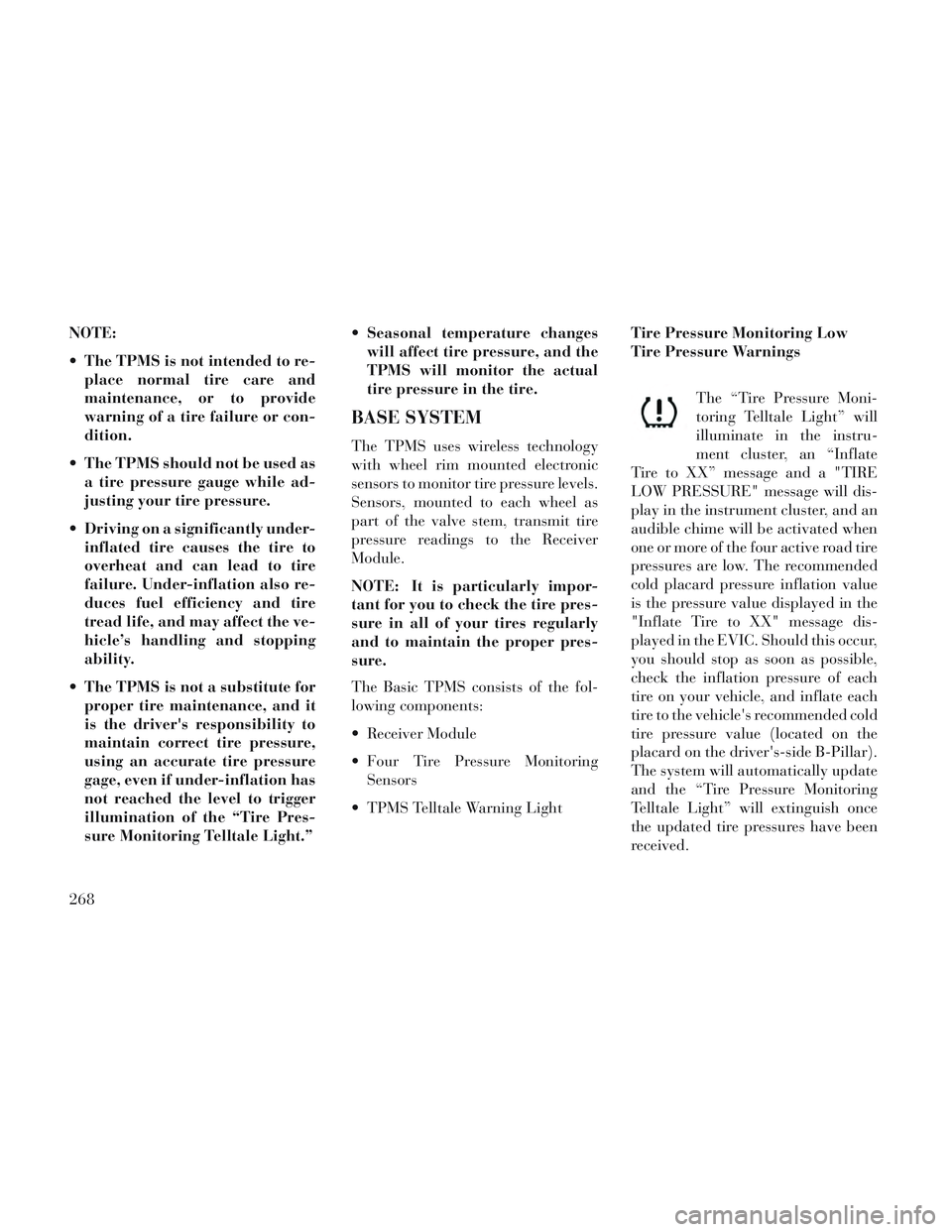
NOTE:
The TPMS is not intended to re-place normal tire care and
maintenance, or to provide
warning of a tire failure or con-
dition.
The TPMS should not be used as a tire pressure gauge while ad-
justing your tire pressure.
Driving on a significantly under- inflated tire causes the tire to
overheat and can lead to tire
failure. Under-inflation also re-
duces fuel efficiency and tire
tread life, and may affect the ve-
hicle’s handling and stopping
ability.
The TPMS is not a substitute for proper tire maintenance, and it
is the driver's responsibility to
maintain correct tire pressure,
using an accurate tire pressure
gage, even if under-inflation has
not reached the level to trigger
illumination of the “Tire Pres-
sure Monitoring Telltale Light.” Seasonal temperature changes
will affect tire pressure, and the
TPMS will monitor the actual
tire pressure in the tire.
BASE SYSTEM
The TPMS uses wireless technology
with wheel rim mounted electronic
sensors to monitor tire pressure levels.
Sensors, mounted to each wheel as
part of the valve stem, transmit tire
pressure readings to the Receiver
Module.
NOTE: It is particularly impor-
tant for you to check the tire pres-
sure in all of your tires regularly
and to maintain the proper pres-
sure.
The Basic TPMS consists of the fol-
lowing components:
Receiver Module
Four Tire Pressure MonitoringSensors
TPMS Telltale Warning Light Tire Pressure Monitoring Low
Tire Pressure Warnings
The “Tire Pressure Moni-
toring Telltale Light” will
illuminate in the instru-
ment cluster, an “Inflate
Tire to XX” message and a "TIRE
LOW PRESSURE" message will dis-
play in the instrument cluster, and an
audible chime will be activated when
one or more of the four active road tire
pressures are low. The recommended
cold placard pressure inflation value
is the pressure value displayed in the
"Inflate Tire to XX" message dis-
played in the EVIC. Should this occur,
you should stop as soon as possible,
check the inflation pressure of each
tire on your vehicle, and inflate each
tire to the vehicle's recommended cold
tire pressure value (located on the
placard on the driver's-side B-Pillar).
The system will automatically update
and the “Tire Pressure Monitoring
Telltale Light” will extinguish once
the updated tire pressures have been
received.
268
Page 279 of 364

when using high quality unleaded
gasoline with a minimum research oc-
tane rating (RON) of 91.
Light spark knock at low engine
speeds is not harmful to your engine.
However, continued heavy spark
knock at high speeds can cause dam-
age and immediate service is required.
Poor quality gasoline can cause prob-
lems such as hard starting, stalling,
and hesitations. If you experience
these symptoms, try another brand of
gasoline before considering service for
the vehicle.
Over 40 automobile manufacturer's
world wide have issued and endorsed
consistent gasoline specifications (the
World Wide Fuel Charter, WWFC)
which define fuel properties necessary
to deliver enhanced emissions, perfor-
mance, and durability for your ve-
hicle. The manufacturer recommends
the use of gasoline that meets the
WWFC specifications if they are
available.METHANOL
(Methyl or Wood Alcohol) is used in a
variety of concentrations when
blended with unleaded gasoline. You
may find fuels containing 3% or more
methanol along with other alcohols
called cosolvents. Problems that re-
sult from using methanol/gasoline or
E-85 Ethanol blends are not the re-
sponsibility of the manufacturer.
While MTBE is an oxygenate made
from Methanol, it does not have the
negative effects of Methanol.
CAUTION!
Do not use gasolines containing
Methanol. Use of these blends may
result in starting and drivability
problems and may damage critical
fuel system components.
ETHANOL
The manufacturer recommends that
your vehicle be operated on fuel con-
taining no more than 10% ethanol.
Purchasing your fuel from a reputablesupplier may reduce the risk of ex-
ceeding this 10% limit and/or of re-
ceiving fuel with abnormal properties.
It should also be noted that an in-
crease in fuel consumption should be
expected when using ethanol-blended
fuels, due to the lower energy content
of ethanol.
Problems that result from using
methanol/gasoline or E-85 Ethanol
blends are not the responsibility of the
manufacturer. While MTBE is an oxy-
genate made from Methanol, it does
not have the negative effects of
Methanol.
CAUTION!
Use of fuel with Ethanol content
higher than 10% may result in en-
gine malfunction, starting and op-
erating difficulties, and materials
degradation. These adverse effects
could result in permanent damage
to your vehicle.
273